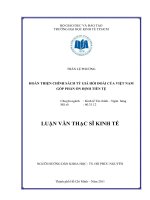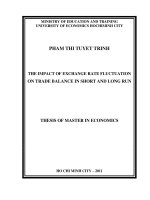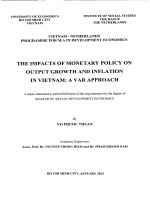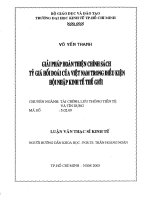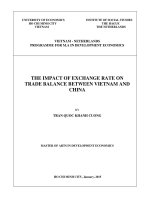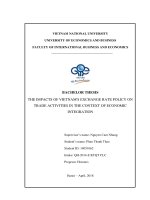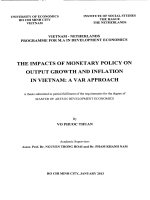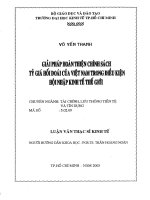The impact of exchange rate policy on trade balance and inflation in Vietnam = Tác động của chính sách tỷ giá hối đoái đối với cán cân thương mại và lạm phát ở Việt Nam
Bạn đang xem bản rút gọn của tài liệu. Xem và tải ngay bản đầy đủ của tài liệu tại đây (715.91 KB, 74 trang )
NATIONAL ECONOMICS UNIVERSITY
INSTITUTE OF PUBLIC POLICY AND
MANAGEMENT
ERASMUS UNIVERSITY
ROTTERDAM INSTITUTE OF
SOCIAL STUDIES
VIETNAM – NETHERLANDS PROJECT FOR MASTER’S PROGRAM IN DEVELOPMENT ECONOMICS
THESIS
THE IMPACT OF EXCHANGE RATE POLICY ON TRADE
BALANCE AND INFLATION IN VIETNAM
Student: Duong Thanh An
Class: MDE 12
Supervisor: Nguyen thi Thuy Vinh, PhD
Ha noi, 2014
TABLE OF CONTENTS
Ha noi, 2014 1
TABLE OF CONTENTS 2
LIST OF ABBREVIATION 4
LIST OF TABLES 5
LIST OF FIGURES 7
CHAPTER 1 1
INTRODUCTION 1
1.1The criticality of the study 1
1.2Research Purpose 2
1.3Scope of the Study 2
1.4Research Methodology 2
1.5Structure of the Thesis 3
CHAPTER 2 4
THEORETICAL FOUNDATION OF IMPACT OF EXCHANGE RATE ON 4
TRADE BALANCE AND INFLATION 4
2.1 Basic concepts of exchange rate 4
2.2Impacts of exchange rate on trade balance 8
CHAPTER 3 21
OVERVIEW OF THE IMPACT OF EXCHANGE RATE ON TRADE BALANCE AND INFLATION IN VIETNAM
21
CHAPTER 4 45
EMPIRICAL STUDY ON THE IMPACT OF EXCHANGE RATE ON TRADE BALANCE AND INFLATION IN
VIETNAM 45
LIST OF ABBREVIATION
ASEAN Association of Southest Asia
CIEM Central Institute for Economic Management
CPI Comsumer Price Index
EU European Union
FDI Foreign Direct Investment
IFS International Financial Statistics
IMF International Moneytary Fund
PPP Purchasing Power Parity
WB World Bank
WTO World Trade Oranization
LIST OF TABLES
Ha noi, 2014 1
Ha noi, 2014 1
TABLE OF CONTENTS 2
LIST OF ABBREVIATION 4
LIST OF TABLES 5
LIST OF FIGURES 7
CHAPTER 1 1
INTRODUCTION 1
1.1The criticality of the study 1
1.2Research Purpose 2
1.3Scope of the Study 2
1.4Research Methodology 2
1.5Structure of the Thesis 3
CHAPTER 2 4
THEORETICAL FOUNDATION OF IMPACT OF EXCHANGE RATE ON 4
TRADE BALANCE AND INFLATION 4
2.1 Basic concepts of exchange rate 4
2.2Impacts of exchange rate on trade balance 8
CHAPTER 3 21
OVERVIEW OF THE IMPACT OF EXCHANGE RATE ON TRADE BALANCE AND INFLATION IN VIETNAM
21
CHAPTER 4 45
EMPIRICAL STUDY ON THE IMPACT OF EXCHANGE RATE ON TRADE BALANCE AND INFLATION IN
VIETNAM 45
LIST OF FIGURES
Ha noi, 2014 1
Ha noi, 2014 1
TABLE OF CONTENTS 2
LIST OF ABBREVIATION 4
LIST OF TABLES 5
LIST OF FIGURES 7
CHAPTER 1 1
INTRODUCTION 1
1.1The criticality of the study 1
1.2Research Purpose 2
1.3Scope of the Study 2
1.4Research Methodology 2
1.5Structure of the Thesis 3
CHAPTER 2 4
THEORETICAL FOUNDATION OF IMPACT OF EXCHANGE RATE ON 4
TRADE BALANCE AND INFLATION 4
2.1 Basic concepts of exchange rate 4
2.2Impacts of exchange rate on trade balance 8
CHAPTER 3 21
OVERVIEW OF THE IMPACT OF EXCHANGE RATE ON TRADE BALANCE AND INFLATION IN VIETNAM
21
CHAPTER 4 45
EMPIRICAL STUDY ON THE IMPACT OF EXCHANGE RATE ON TRADE BALANCE AND INFLATION IN
VIETNAM 45
ACKNOWLEDGEMENT
The thesis is completed under guidelines by Doctor Nguyen Thi ThuyVinh. I would like to
present my deep gratitude for her attentive and caring instructions.
During the research period, I have been given with a great deal of cares, encouragement,
and precious contributions from my family, colleagues of where I have been working,
researchers with similar interests in the topic that I have pursued. I am honored to show my
great thanks.
On this occasion, I am much grateful to the Institute of Public Policies and Management -
National Economics University and particularly to Doctor Giang Thanh Long who have
created favorable conditions for me to complete this research program.
CHAPTER 1
INTRODUCTION
1.1 The criticality of the study
As early as the second half of the last century, many countries like Japan and South Korea
consider exchange rate policy as an effective tool of their international trade policy to
improve trade deficit, increase international reserve, and boost international trade for the
ultimate goal of becoming an Asian economic dragons. At its early stage of economic
reform, China also embraced the “magical stick” of exchange rate to benefit from their
export, keeping a consistent trade surplus with the US and becoming the country with
biggest foreign exchange reserve. Alan Greenspan, former Chairman of US Federal
Reserve, also tried to devalue US dollar to promote export and reduce trade deficit. On Dec
10, 2003, in order to explain his weak-dollar monetary policy, he said ambiguously on
CNN: “Now it is the time American should know the export potential…”. Since 2013, the
world has merely seen a sharp devaluation of the Japanese yen. This phenomenon has also
put a lot of controversy whether the Japanese currency devaluations to promote exports.
In Vietnam, trade deficit, which has been a persistent issue during the last 20 years, not
only shows weaknesses of the country’s economy but also implies potential instability in
the long run. The goal to have a balance in international trade in 2008, which was indicated
in International Trade Strategy during 2001-2010, was not met. In the past years, inflation
in Vietnam pretty high compared to other countries in the world while nominal exchange
rate of VND/USD was relatively stable. Therefore, there was many researchers suppose
that Vietnamese currency was overvalued and then give some suggestions on currency
devaluation to boost export as many countries in the world have ever done to improve the
trade balance. But other experts also noted that the devaluation can cause inflation, a
problem that Vieatnam has trying to solve.
There are many studies on impact of devaluation on trade balance or studies on exchange
rate pass-throught on domestic price in some countries in the world including Vietnam
(Nguyen Van Tien, 2009; Nguyen Thi Hien, 2011, Nhat Trung, 2011; Nguyen Duc Thanh,
2011; Nguyen Thi Kim Thanh, 2011). However, all of these researches have only focused
on either the inflation aspect or trade balance aspect rather than taken the trade-off between
them into consideration: a devaluation may improve trade balance but can cause inflation
in the economy. Therefore, it is very important to study the impact of change in exchange
1
rate on both trade balance and inflation in Vietnam to have a sound exchange rate policy
which can improve trade balacne without creating pressure on inflation.
1.2 Research Purpose
From the above analysis, the thesis has selected research topic as “The impact of
exchange rate policy on trade balance and inflation in Vietnam” which aims to answer
the following questions:
• Whether the changes in exchange rate affect trade balance and inflation in
Vietnam?
• What does a devaluation affect trade balance and inflation in past years?
• What should Vietnamese policy makers adjust to exchange rate policy to improve
trade balance without accelerating inflation in Vietnam?
1.3 Scope of the Study
The study mainly focuses the impact of nominal exchange rate of U.S dollar against
Vietnamese dong (USD/VND) on trade balance and inflation in Vietnam over the period
2000 - 2012. Beside, the study also consider the role of other exchange rates of main
trading partners’ currencies against VND in improving trade balance and controlling
inflation such as CNY/VND, EUR/VND, JPY/VND and SGD/VND.
1.4 Research Methodology
The author uses a combination of research methodologies including literature study,
qualitative analysis, comparative study, etc.
Besides, the thesis also investigates this isues using vector autoregression (VAR) model
because exchange rate, trade balance and inflation are interdependence relationships. VAR
model is one of the most successful, flexible, and easy to use models for the analysis of
multivariate time series. It is a natural extension of the univariate autoregressive model to
dynamic multivariate time series. The VAR model has proven to be especially useful for
describing the dynamic behavior of economic and financial time series and for forecasting.
The study applies VAR model to confirm if the causal relationships among variables exist
and what impact directions of the relationships are. The study also computes impulse
response functions to know the impact of a shock in depreciation on trade balance and
inflation and computes variance decomposition to understand the role of exchange rate in
the variance of trade balance and inflation.
2
For empirical study, the thesis uses monthly data from 2000 to 2012.
1.5 Structure of the Thesis
The thesis includes 5 chapters as follow:
• Chapter 1 - Introduction
• Chapter 2 - Theoretical foundation of impact of exchange rate on trade
balance and inflation
• Chapter 3 - Overview of the impact of exchange rate on trade balance
and inflation in Vietnam
• Chapter 4 - Empirical study on impact of exchange rate on trade
balance and inflation in Vietnam
• Chapter 5 - Suggestions on improving the effectiveness of exchange
rate policy without creating pressure on inflation
3
CHAPTER 2
THEORETICAL FOUNDATION OF IMPACT OF EXCHANGE RATE ON
TRADE BALANCE AND INFLATION
2.1 Basic concepts of exchange rate
2.1.1 Definition of exchange rate
Although globalization and economic integration have been increasing and became a
global trend, most of countries still maintain its own currency. The growing international
trades and economic activities among countries brought about the needs for exchange
between currencies in certain conventions. Because of the need, exchanged rates came into
usage “Exchange rate is the comparative relationship between two currencies of two
countries”(Dinh Xuan Trinh, 2006).
When economic relations among countries became more sophisticated, especially given
the creation of letter of credits in foreign currencies, which are tradable in foreign
exchange market of a country, exchange rate was alternatively considered in a more
comprehensible manner as” the price of one currency in another country’s currency”.
For example, American businesses could import goods from United Kingdom and the
method of payment was determined as checks. These American importers had to pay
USD160 to buy a check value of GBP100 in an U.S. bank to pay for the Britain exporters.
These exporters, subsequently, deposited the checks at a Great Britain banks and received
GBP100. Consequently, the price of one GBP was 1.6 U.S. dollar and this is the exchange
rate between GBP and USD.
From a country’s perspective, there are two ways to interpret exchange rate:
- “Exchange rate is the price of the local currency in a foreign currency”: this
definition is used in some countries which list the exchange rate in indirect manner
(Local currency/Foreign currency) such as U.K., U.S…In such way, the price of
foreign currency is not externally expressed.
- “Exchange rate is the price of a foreign currency in a local currency”: The
definition is used in countries which implement indirect quotation (Foreign
currency/Local currency). Currently, most of countries, including Vietnam, use the
quotation convention. In Vietnam, according to the Foreign Exchange Ordinance
4
No. 28/2005/PL-UBTVQH11, Article 4, Clause 9 exchange rate is defined as the
price of a foreign currency in the local currency of Vietnam, Vietnamese Dong
(National Assembly Standing committee, 2006).
Within the scope of the research, if there’s no specific note on terms used, those terms
“exchange rate”, “foreign exchange rates” are used interchangeably to specify the price
of the foreign currency (USD) in the local currency of Vietnamese Dong. With that being
said, the increases in exchange rate mean the local currency depreciates and vice versa.
2.1.2 The determinants of exchange rate
Inflation differential
There were many economic events in history proving the impact of inflation differential on
exchange rate, particularly the hyper-inflation in Germany. In 1920s, Germany printed so
much money to pay for government’s spending and the consequence is the price index in
1924 jumped 6.666.666,7% compared to that of 1923. Germany’s Mark depreciated to a
historical record (Johnathan Mc.Cathy, 1998). The impact of inflation differential on
exchange rate can be presented relatively in the form of Purchasing Power Parity (PPP)
model as below:
We define P
D
, P
F
and e as local price, foreign price, and exchange rate respectively at the
beginning of a certain year, ∆P
D
, ∆P
F
and ∆e are percentage changes of local good price,
foreign good price and exchange rate respectively calculated at the end of the year.
- PPP at the beginning of the year: P
D
= e * P
F
- PPP at the end of the year: P
D
(1+∆P
D
)=e(1+∆e).P
F
(1+∆P
F
)
- Therefore, (1+ ∆P
D
)=(1+∆e)(1+∆P
F
), or ∆e=
Under normal economic conditions: ∆P
F
≈0 so that ∆e≈∆P
D
- ∆P
F
Hence, assuming there is no change in other factors, the change in exchange rate is
approximate to the difference between inflation levels of the two countries.
Interest rate differential between local currency and foreign currency
The first model on the impact of interest rate differential between local currency and
foreign currency on exchange rate was first proposed by the Interest Rate Parity theory
5
(IRP) of John Maynard Keynes. The foundation of IRP is: the equilibrium of foreign
exchange market requires the equilibrium of interest rates; interest rates of deposits in two
different currencies must be the same when converting into one currency. Keynes
explained that under normal conditions, arbitrage opportunities will prevail until forward
prices are in line with interest rate differential. As a result, interest differential is off set by
profit or loss on the forward market. Thus, the lower interest rate on one country’s
currency will be compensated by higher forward price compared to that of the currency of
the country with higher interest rates.
For example, in Vietnam, interest rate for USD deposits is I
F
(%/period of time),
interest rate for VND deposits is I
D
(%/period of time). The current exchange rate is 1
USD=e
S *
VND. After a period of time T, one USD would yield (1+I
F
T)*USD, while e
S
*
VND yields e
S*
(1+I
D
T)*VND. Calling e
F
is the exchange rate at T. Based on IRP, one
USD and e
S
*VND must yield the same interest when converting in one currency:
1 + I
F.
.T = = = .T or .T
If T=1 then ≈I
D
-I
F
, in other words, If other factor unchange, the
change in exchange rate will be proportional to the difference between interest rates of
local currency and foreign currency.
Foreign currency interest rate difference between domestic and foreign market
If a country has higher interest rate on foreign currency deposits compared to that of
another country, that country with higher interest rate would attract capital flows from
outside into it and the inflow would push the supply of foreign currency up. Because of the
exogenous factor, the supply curve of USD moves rightward, the exchange rate goes down.
One of the most prominent efforts on quantifying the impact of foreign currency’s interest
rate differential between domestic and foreign markets was International Fisher Effect
(IFE) proposed by the economist Irvine Fisher. IFE said that the real interest rates of
different currencies of open economies would be equalized.
We define i
f
(%/period of time) as the interest rate of USD deposits in the U.S, i
d
(%/period
of time) as the interest rate of USD deposits in Vietnam, ∆P
D
and ∆P
F
as inflation rates in
6
Vietnam and the U.S respectively. After a period of time T, 1$ deposit in the U.S. would
yield (1+i
f
T)$ or, adjusted to inflation in the U.S, $. Meanwhile, 1$ in Vietnam
would yield (1+i
d
T)$ or, adjusted to inflation in Vietnam, $.
Based on IFE, the two real interest rates must be equal:
= =
Combining this with relative PPP,
If T = 1 then ≈i
d
-i
f
. This means when all else remains unchanged, the change in
exchange rate would be equal to the different between interest rates of the foreign currency
in domestic market and foreign market.
However, sometimes the interest rate differential did not make the change in exchange
rate. These situations normally happen when an economy is in unstable, potentially crisis-
like, condition. Under that situation, even though how high the interest rate would be,
investors will not risk their capital to earn profit from interest rate differential. A typical
example of the situation is the economic crisis during the period of 1971-1973; the interest
rate in New York market was 1.5 times that of London market, triple that of Frankfurt
market but the short-term capital flow were not directed to New York but to Western
Germany and Japan.
Protectionism
Protectionism policies are tariffs, tax and non-tax trade barriers used by countries to protect
and enhance their industries’ competitiveness in international trade. The increased use of
protectionism like tariffs, quotas limits the volume of imports and subsequently reduces the
7
demand for foreign currency (the demand curve shits leftward) and in the long-run the
exchange rate will go down, local currency appreciates against foreign currency. For
example, if Vietnam increases the tariff on imported laptops from the U.S, this will make the
price of those imported laptops increased, demand going down (demand curve shifts
leftward) and exchange rate going down, VND appreciating against USD. The paradox of
protectionism is while tariffs and trade barriers are used to reduce import, supporting local
manufacturing and export industries, protectionism policies push the local currency to
appreciate. The appreciation of the local currency, in turn, negatively limits exports. In
summary, protectionism, in its relation with exchange rate, gives rise to an undesired result.
2.2 Impacts of exchange rate on trade balance
Exchange rate policy is a system of tools which are used to control the supply and demand
relationship on foreign exchange market and as a result adjust exchange rate to meet
desired goals. A highly-valued local currency compared to foreign currencies would
support export and limit import and vice versa. Thus, managing exchange rate policies can
have direct impact on trade balance. In addition, every time central banks announce
adjustments on foreign exchange rate policies, the debates on effect of such adjustment on
prices and inflation are emerged.
2.2.1 Exchange rate’s impacts on import and export performance
Volume effect
If the exchange rate, expressed in local currency, is high, with the same amount of foreign
currency the exporter receives from their export, these exporters will have more local
currency when exchanging their foreign currency to local one. For example, a Vietnamese
exporter sold an amount of goods worth USD100.000 to an overseas importer with payment
term of 3 months. At the moment, the exchange rate is 1 USD = 15.000 VND. After 3
months, the exchange rate becomes 1 USD = 16.000 VND and the importer makes the
payment of USD 100.000 to the exporter. When converting the receipt proceed into VND at
the time of payment, the exporter earns (16.000-15.000)*100.000 = 100.000.000 VND of
profit from exchange rate volatility. On the other hand, the low exchange rate, i.e. the local
currency is highly valued, will make revenues collected from export activities reduced in
local currency term; export is not encouraged and there would be decreasing trend in export.
The topic was debated frequently on the U.S.’s public media at the end of 2002, right before
8
FED’s implementation of weak-dollar policy. The New York Times, on Dec 21, 2002,
reported that the 10% appreciation of USD against other major currencies including JPY
would make the country’s export revenue decrease from 10% of GDP to 7% of GDP.
In conclusion, exchange rate, in local currency term, has impacts on the volume of goods
exported in the way that: if exchange rate increases, export volume would increase and vice
versa, if exchange rate decrease, volume of goods exported could decrease. The change in
volume of exported goods is called “volume effect” of exchange rate’s impact on export.
However, volume effect does not have immediate effect on export activities but it rather has a
certain lag of, normally, several months. These three months are the window of time during
which the exporters consider the pros and cons of more export given the exchange rate
volatility. When the exchange rate increases, exporters need time to adjust their production
schedule, negotiating new export contracts and expanding supply chain. When the exchange
rate decreases, exporters still have to honor signed contracts, willing to push sales for those
produced goods at the cost of loosing margins because of exchange rate volatility.
Foreign exchange rate changes impact the volume of imports in the opposite way as it does
with exports: If the exchange rate increases, the volume of imports will decrease and vice
versa, if exchange rate decrease, the volume of import tends to increase. The fluctuation in
volume of imports as a result of exchange rate change is called exchange rate’s volume
effect on imports.
There have been multiple of evidences demonstrating the volume effect of exchange rate
on imports. For example, in Jan 1999, Argentine Peso appreciated 10% against Brazilian’s
Real and the appreciation resulted in 30% increase in the import of shoes from Brazil to
Argentina in the same year.
On the other hand, assuming a laptop imported from the U.S. to Vietnam has a price of
USD1000. The current exchange rate is 1USD = 15.000VND. These means a Vietnamese
has to pay VND15.000.000 for an imported laptop. Assuming the exchange rate is now
1USD=VND18.000. Given the new exchange rate, a Vietnamese now has to pay
18.000.000VND for the same imported laptop. So instead of paying 3.000.000VND more,
the Vietnamese can switch to locally-manufactured laptops and desktops. The demand for
imported laptops would decrease and subsequently laptops imported from the U.S. will
also go down.
As in the case of export, volume effect does not have immediate impact on import
9
activities but rather also has a lag. The lag of time allows importers to consider benefits of
imports given exchange rate change. When exchange rate, expressed in local currency,
goes down, importers need time to negotiate more import contracts, selecting and verifying
goods offered by new exporters who would not benefit without the exchange rate change.
When exchange rate goes up, the importers still have to honor previously-signed contracts
even if this means absorbing loss as a result of exchange rate volatility.
Price effect
As elaborated above, because of time-lagging feature of volume effect, exchange rate
fluctuation would not impact export volume immediately. However, there’s another effect
needed to be study during the transition period and it is named price effect. Assuming the
current exchange rate is 1USD = 15.000VND and the price of exported good is 2.000VND
in local currency. Before exchange rates increases, each unit of exported good is worth
0,1333USD (2000/15000). If the exchange rate is now 1 USD = 18.000VND, each unit of
exported good is only worth 0,1111USD now (2000/18000). On the other hand, if the
exchange rate falls to 1USD = 10.000VND, each unit of exported good will bring about
0,2USD (2000/10000). The Price Effect on export volume says that even though the
Volume Effect may not have immediate effect, exchange rate fluctuation will have
immediate impact on the value of export: if the exchange rate, as expressed in local
currency, rises, value of export will decrease in term of foreign currency and vice versa, if
exchange rate falls, value of export will increase in term of foreign currency.
The Price Effect on import volume says that even though the Volume Effect may not have
immediate effect, exchange rate fluctuation will have immediate impact on the value of
import in term of local currency: if the exchange rate, as expressed in local currency, rises,
value of import will be higher in term of local currency and vice versa, if exchange rate falls,
value of import will be lower in term of local currency. For example, a computer mouse
imported from the U.S has the price of 2USD/unit. If the exchange rate is
1USD=15.000VND, the local-currency price of the mouse would be 30.000VND. If the
exchange rate rises to 1USD=18.000VND, the new price is now 2*18.000VND =
36.000VND/unit. A Vietnamese buyer has to pay 6.000VND more for each imported mouse.
Impact of exchange rate on structure of imported and exported goods
Among exported goods, agricultural products and raw materials are more sensitive to
exchange rate volatility compared to other products including machinery, complete built
10
units (CBU), gasoline, etc. The reason for the difference is those raw materials and
primitive goods are easier to find substitutes while machinery, manufacturing components
and gasoline tend to be more difficult to find substitutes. If exchange rate falls, exported
goods become relatively more expensive and those easy-to-be-substituted goods are first to
be removed from foreigners’ consumption list and the percentage of the goods out of all
exported goods would fall. Assuming that American consumers buy Vietnamese coffee at
the price of 8.000VND/kg, when the exchange rate is at 1USD = 16.000VND, an
American has to pay 0,5 USD for 1 kilogram of Vietnamese coffee. When the exchange
rate falls down to 1USD = 10.000VND, the American has to pay 0,8USD for the same
kilogram of coffee. Because coffee is a good which is easy to be substituted, the American
could simply switch to coffee from Brazil or other types of beverage such as black tea
instead of bearing 0.3USD more for each kilogram of coffee. If Vietnam keeps the
exchange rate unchanged and cost of producing coffee locally does not go down, the U.S.’s
demand for coffee of Vietnam will decrease. When there is no demand, the good would be
removed from export list to the U.S. On the other hand, if exchange rate rises, list of goods
exported would be expanded to include more diversified goods because: firstly, businesses,
which could not have competed before, now can export and benefit from the exchange rate
rise; secondly, an increase in revenue of export allows these businesses to expand
production and diversify their own product categories.
For similar goods, the goods which consumes large amount of local materials are more
sensitive to exchange rate and those goods relying more on imported materials are less
sensitive. For example, the price of a shirt made of 50% imported materials is
100.000VND. The original exchange rate is 1USD = 15.000VND so the price of the shirt
in USD is 6,667USD.
If the exchange rate rises to 1USD = 18.000VND then the input cost will increase by
50%x100.000x3000/15.000 = 10.000VND. The price of the shirt now is 110.000/180.000
= 6,111USD. If the shirt is made of 100% local materials, the converted price of it would
be 100.000/18.000 = 5,556USD. In summary, goods which have high percentage of
imported contents are less impacted by exchange rate fluctuation.
When exchange rate moves down, list of imported goods tend to expand because: firstly,
local consumers, who could not have afforded for them because of high prices before, now
would buy them given their lower prices in local currency now; secondly, improved
revenues of imports help these businesses expand production and diversify their products.
11
If exchange rate rises, the conversion to local currency becomes more expensive and the
fact would curb the demand for imported goods. When the demand reaches zero, these
goods are excluded from import list.
Exchange rate’s impacts on each type of imported goods depend on how easy to substitute
the good. There are certain goods such as agricultural products and raw materials are more
prone to exchange rate fluctuation. While other goods such as gasoline, machinery and
complete built units, which are more difficult to be substituted, are normally not sensitive
to exchange rate volatility.
For example, Petrolimex imports diesel from Singapore at a price of 600USD/ton. When
exchange rate is 1USD = 15.000VND, Petrolimex has to pay 9.000.000VND for a ton in
local currency. If the exchange rate moves to 1USD = 18.000VND, the cost in local
currency is 10.800.000VND/ton. Even though the local cost has increased by
1.800.000VND but because Vietnam could not produce the product on its own and other
countries also quote diesel price in USD, Vietnam has no choice but continue to import
diesel from Singapore.
2.2.2 Currency devaluation and trade balance: J-Curve Effect
Currency devaluation is an actively-debated topic within academic community and there
are two prevailing of opinion: supporting group and objecting one. The supporting group,
which is comprised of foreign economist, praises a substantial devaluation to improve the
competitiveness of goods, promoting export growth and restructuring the economy,
removing challenges faced by businesses and reducing fiscal deficit. Meanwhile, local
economists are suspicious of positive impacts of currency devaluation, arguing that
devaluation could push inflation higher, damage consumers’ confidence on public policies
and increase public debt.
The concept of currency devaluation
Currency devaluation is a deliberate downward adjustment to a country's official exchange
rate relative to other currencies. In a fixed exchange rate regime, only a decision by a
country's government (i.e central bank) can alter the official value of the currency. It
contrasts to "revaluation". The representation of currency devaluation is the increase of
exchange rate. The core idea of currency devaluation is that a country reduces purchasing
power of its currency from its real purchasing power against that of foreign currencies.
Example: In September 1992, GBP was devalued by more than 20%, making the exchange
12
change from 1GBP = 2,95 DEM to 1GBP = 2,35 DEM (Tran Ngoc Tho and Nguyen Ngoc
Dinh, 2005). In the past, the term “devaluation” was only used in fixed exchange rate
regimes while the term “depreciation” was used in floating exchange rate regimes.
J-Curve Effect
Currency devaluation is represented by the sharp increase in exchange rate, which is
expressed in local currency. The increase of exchange rate impacts export and import
activities as analyzed in Volume Effect and Price Effect part. In addition, currency
devaluation also creates what’s so called J-Curve Effect
Figure 2.1: J-Curve Effect in currency devaluation
Figure 2.1 examines the behavior of Vietnam’s trade balance in VND under currency
devaluation assuming that the trade account is balanced originally. After the currency
devaluation which happens at T = 0, exchange rate rises and as a result, prices of imported
goods in local currency also go up and the total value of imports rises either. The trade
account starts being in deficit. At the beginning, because of the timing lag of Volume
Effect, the value of export grows gradually. Even though the growth of export value
intensifies, once export value grows at slower rate than that of import growth, trade
account would still be in deficit.
However, after a period of time when the Volume Effect has more impact than the Price
Effect and the growth of total value of export exceeds that of import, the trade account would
be balanced, represented by the upward move of the graph starting from point T
1
. From T
2
,
trade account becomes surplus. The behavior of trade account is called the J-Curve Effect of
13
currency devaluation. There’re many evidences proving the existence of J-Curve when a
country devalues its currency. For example, in 1991, Krugman analyzed the impact of the
sharp currency devaluation of USD during the period of 1985-1987 (According to the Plaza
agreement on the exchange rate, which the U.S signed with several countries in September
1985. The dollar is adjusted depreciation) and found the existence of the J-Curve Effect in
U.S. economy. At the beginning, trade account was deficit, in both absolute value and as
percentage of GDP, but trade account was improved after 2 years. The trade deficit came
down from a record of USD158 billion in 1987 to USD107billion in 1989.
In compliance with the Plaza Accord signed between the U.S and some other countries in
September 1985, the USD was devalued up to 50% until 1987.
The effectiveness of improving trade account using currency devaluation
Based on the long-term effect of currency devaluation, WB and IMF normally suggest
currency devaluation when some country faces difficulty in trade account. These
institutions consider currency devaluation as an effective method which can help those
countries, including Vietnam, with developing export industries to fight against the threat
of trade deficit. However, there are examples showing that currency devaluation does not
always help improve the trade deficit situation. A quantitative research done by Zhaoyong
Zhang (1996) on monthly data series from January 1991 to February 1996 could not find
any correlation between exchange rate movements and trade account of China, even
though during the period China had devalued its currency of CNY by 50% through a series
of exchange rate interventions.
Based on pragmatic approach, there is an objective need to understand under what
conditions that currency devaluation would improve trade account. The condition which is
called Marshall-Lerner Condition was developed based on elasticity concept.
Calling η
X
the exchange rate elasticity of demand for export, i.e.by how much, in
percentage, export would change if the exchange rate rises by 1%, η
M
is exchange rate
elasticity of demand for import or by how much, in percentage, import would change if
exchange rate rise by 1%. The Marshall-Lerner Condition asserted that currency
devaluation will only improve trade account if η
x
+ η
M
>1.
Studies done by Artus and Knight (1984) pointed out that those indexes η
x
and η
M
are
smaller in short-run than in the long-run. Meanwhile, in 1987 Gylfason announced a
summary based on 10 empirical studies from 1969 to 1981 in 15 developed countries and 9
developing countries and the generalization shows that these elasticity indexes were high
and Marshall-Lerner Condition was all met.
14
The fact that the elasticity indexes are normally smaller in short-run than in long-run,
together with Marshall-Lerner Condition, lead us to some key factors a country should
consider before devaluing its currency to improve its trade account:
Firstly, in short-run currency devaluation would worsen, not improve, trade account
because, in short-run, those indexes η
x
and η
M
are normally small and could not meet the
Marshall-Lerner Condition.
Secondly, if a country wants a high exchange rate elasticity of demand for export, it must
select to export those goods which have large supply sources and those sources could be
easily expanded to take advantage of favorable currency movement. Raw materials
normally depend on natural conditions and it is hard to quickly expand their supplies. In
general, only highly-processed goods meet the condition.
Thirdly, if a country wants a high exchange rate elasticity of demand for import, it must
import only those goods which are easy to be substituted. Those goods such as machinery,
complete-build units or components, oil and gas for production normally make import
inelastic to exchange rate movement.
Fourthly, using currency devaluation to improve trade account requires accurate estimation
of exchange rate elasticity of export and import. Not all currency devaluations improved
trade account in the long-run. Currency devaluation could improve trade account only if
elasticity indexes are big enough to meet Marshall-Lerner Condition.
Fifthly, even if those elasticity indexes meet Marshall-Lerner condition, a country, which
wants to devalue its currency, must know that international trade depends not only on
exchange rate but also on other synchronized actions in fiscal policy, income, etc.
Devaluations must be considered in combination with other policies. Lessons learnt from
the Black Tuesday in Russia in 1989 would remind us about this. At that time, the central
bank of Russia did wrongly devalue the Ruble against USD, having Russian people feel
unconfident on the economy. The devaluation led to severe consequences including sharp
increase of goods’ price and export were severely hurt.
In conclusion, exchange rate and trade balance have a very tight relation to each other.
Both theoretical research and empirical studies in different countries proved that exchange
rate could be used to influence both import and export to achieve target trade balance.
However, both exchange rate and trade balance are sensitive macroeconomic indicators
and they are both impacted by multiple factors which make their relationship sometimes
difficult to understand. In theory, exchange rate’s impact on trade balance is represented by
the J-Curve Effect. A more quantitative estimation of exchange rate’s impacts on trade
15
balance is Marshall-Lerner Condition. These are important foundation for export-focused
countries like Vietnam to consider when managing trade balance using exchange rate.
2.3 Impact of exchange rate on inflation
The impacts of exchange rate on prices in local currency are estimated by exchange rate
pass-through effect. Exchange rate pass-through is understood as the percentage change of
domestic prices in currency of the importing country if exchange rate between the two
currencies of the two trade partners changes by 1 percent. In other words, exchange rate
pass-through is really the exchange rate elasticity of price level.
2.3.1 The mechanism of exchange rate’s impacts on price level
The impacts of exchange rate on prices in local currency are estimated by exchange rate
pass-through effect. Exchange rate pass-through is understood as the percentage change of
domestic prices in currency of the importing country if exchange rate between the two
currencies of the two trade partners changes by 1 percent. In other words, exchange rate
pass-through is really the exchange rate elasticity of price level.
Graph 2.1 shows 3 channels through which consumer prices can adjust to changes of
nominal exchange rate: direct, indirect and foreign direct investment.
Direct Effect – The direct effect includes the direct change in prices of both intermediary
and end-consuming imported goods because of higher exchange rate. Empirical research
normally uses imported good prices index to study the effect in an independent way.
Obstefeld and Rogoff (2000) and other researchers proved that imported goods are more
sensitive to exchange rate fluctuation compared to general consumer goods.
Graph 2.1: Mechanism of exchange rate pass-through on inflation
16
Tỷ giá tăng (Phá giá nội tệ)
Direct Indirect FDI Decision
Increased
Prices of
component
made
overseas
Increased
prices of
imported
goods
Increased
demand for
locally-
produced goods
(to replace
imported ones
Increased
demand for
locally-
produced
goods
Increased
demand
for labor;
higher
wages
Increased
production of
local goods as
substitutes for
imported
goods
through FDI
Production of local goods
grows
Higher consumer prices
Exchange rate rises (local currency
devaluation)


